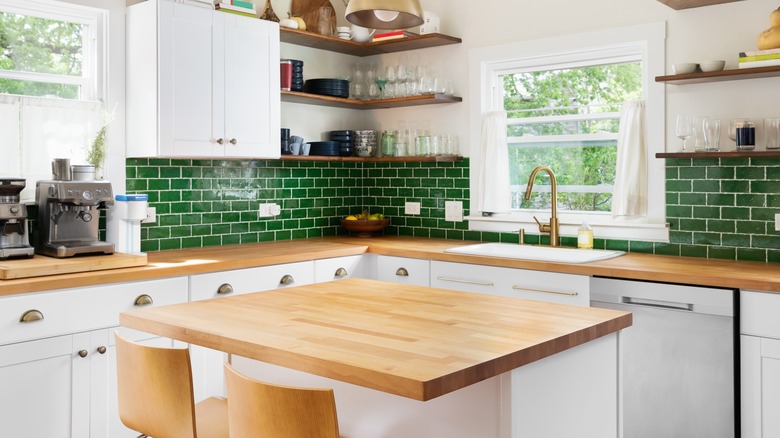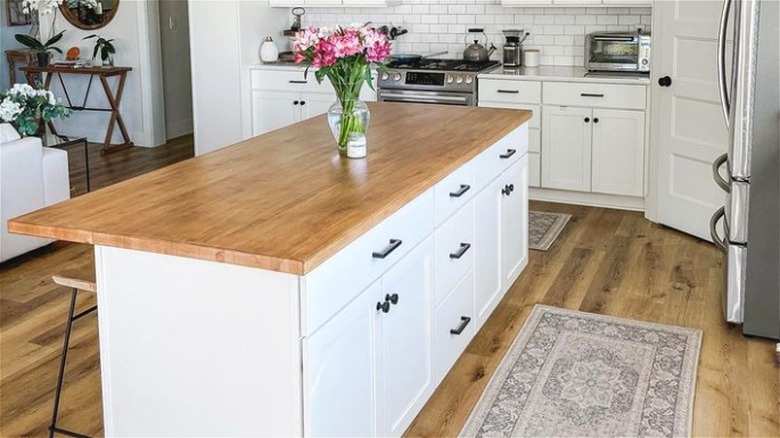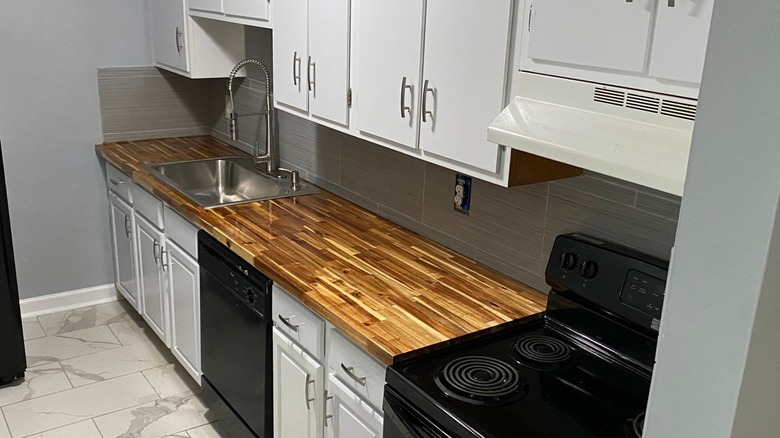Pair Butcher Block Countertops With This Type Of Flooring For A Cohesive Look
Butcher block countertops can bring a cozy, warm, and natural look to your kitchen, and with proper care (including understanding how often you should be sealing butcher block countertops), they can practically last a lifetime. Suitable for a variety of kitchen styles, there are a wide range of butcher block wood types to choose from, including oak, maple, cherry, walnut and more. Plus, they tend to be more affordable per square foot than natural stone countertops. If you're in love with the butcher block countertop trend, you're not the only one, but you might wonder how the countertops will look in your kitchen, especially if you're planning to remodel your floors. Overall, you can't go wrong with a natural, warm-looking floor to match your butcher block countertops.
However, choosing the right floors to complement your butcher block isn't as easy as matching the wood tones. In fact, using the exact same material on your floors and countertops can look a little overwhelming, not to mention off-putting (who wants to eat off of flooring material?). Here's what you need to know to choose a floor type that will enhance your butcher block and round out your kitchen without looking too matchy-matchy, plus the flooring types that should generally be avoided.
Warm, natural flooring complements butcher block
In general, wood, wood-look tile, or wood laminate pair well with butcher block countertops because these flooring materials will give your kitchen warm, laid-back vibes. In homes with a rustic, cottage, or farmhouse aesthetic, wood-look floors will also feel like a natural choice. However, if your kitchen already contains a lot of wood, you may want to opt for another nature-inspired material. Designer Vanessa Horwat explained in an interview with Deslaurier Custom Cabinets Inc., "The more woods you have the more eclectic it becomes. Your kitchen can end up looking extremely busy." A smooth, stained concrete or slate tile can work instead, but should still be in a complementary tone with minimal detail and subtle grout lines.
Your floor doesn't have to match the butcher block completely — in fact, it can be better not to — but it should share an undertone. If you're redesigning a whole kitchen, choose your countertops first. Butcher block wood can contain a variety of color shades, as well as a unique grain pattern. Look closely at your countertops to see what colors they contain, from dark brown to beige or even streaks of black. It may also help to take a picture of your butcher block, then use a color picker tool to discover the undertones that will inspire your flooring. Another way to ensure your floors aren't too matchy-matchy is to opt for a slightly different grain pattern in the wood or laminate floor.
Avoid cold, sterile, or clashing floor styles
Personalizing every inch of your kitchen can be an exciting part of remodeling or designing. Although you can certainly fill your home with whatever flooring you'd like, there are some materials to be wary of if you want to avoid investing in a kitchen flooring trend you might regret. While they are undeniably beautiful, butcher block countertops can already look quite busy, especially if you opt for a dramatic wood grain, vibrant stain, or end grain butcher block. Because of this, it's best to avoid putting busy tiles with bold patterns or dark grout on your kitchen floors, which can be visually overwhelming in the space.
Similarly, any flooring material that feels too cold, shiny and sterile may conflict with the warm and cozy nature of your butcher block. If you're unable to change your current kitchen floors or you prefer a more cool-toned color scheme in your home, you may want to consider a gray butcher block, rather than the traditional natural wood. An option like The Home Depot's acacia butcher block in the shades Dusk Grey or Organic White will blend much better with cool surfaces like white marble or dark porcelain tile.


